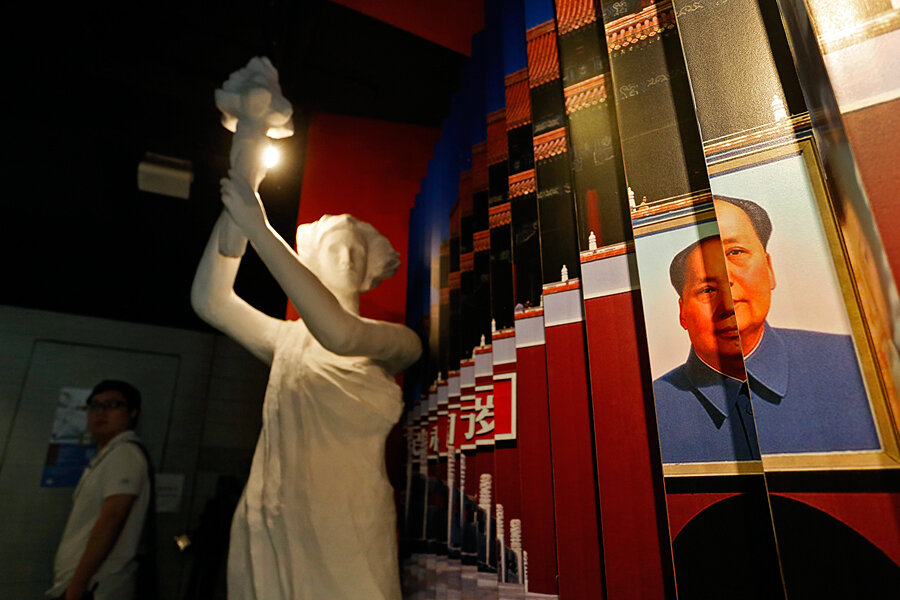A Tiananmen democracy museum on Chinese soil? Only in Hong Kong
Loading...
| Hong Kong
Beijing has been largely successful in scrubbing China’s collective memory of the June 1989 crackdown on the Tiananmen protests. Defying this amnesia, a small museum in Hong Kong commemorates the protests and the brutal response by authorities.
Since opening in April in a nondescript office building in a tourist district, the June 4th Museum has had more than 5,000 visitors. Museum founder and director Lee Cheuk-yan, an opposition politician, estimates half of those are from mainland China, where public discussion of the events of June 4 is taboo and online mentions are vigorously censored. Mainland holidays tend to be the busiest days for the museum, Mr. Lee said (Monday was a public holiday in China).
“Hong Kong has 30 million mainland visitors every year,” he says. “This gives us a new target group that we want to educate about what happened during June 4th.”
Under its separate political and legal system, Hong Kong, a former British colony, enjoys much freer speech than China's mainland. As in previous years, tens of thousands are expected to attend a candlelight vigil tomorrow for the victims of Tiananmen. Hundreds, possibly thousands, of protesters and onlookers are believed to have died in and around the square on June 3-4.
However, a lawsuit funded by other tenants in the museum's building suggests that there are forces pushing against freedom of speech here. The lawsuit alleges that the 800-square-foot museum, which is operated by the Hong Kong Alliance for Patriotic Democratic Movements in China, violates the terms of the property deed.
“We don’t have any proof, but I feel this is very, very likely to be politically motivated,” says Lee. “Who is behind it? We don’t know. But we are confident that we will win the lawsuit.”
On a recent afternoon the museum had a couple dozen visitors. After buying a $1.30 ticket, guests follow a timeline of photos, text, and video from 1989, starting with the death of former Chinese Communist Party leader Hu Yaobang on May 19, and finishing on June 12 in the bloody aftermath of the crackdown. Maps of troop movements and killings and an interactive exhibit supplement the timeline. A small 13-seat cinema shows a documentary of mothers and other relatives of Tiananmen victims recounting their losses.
While most of the material is in Chinese, staff fluent in Cantonese, Mandarin, and English assist visitors when necessary. One young staff member said he took a job at the museum because he wanted to learn more about what happened in Beijing a quarter century ago.
“Most young people in Hong Kong know something big happened in Beijing in 1989, but they aren’t very familiar with the details,” he says.
Personal connections
Lee has a personal connection to Tiananmen. During the protests, he couriered donations from Hong Kong to the student protesters. He was arrested on June 5, 1989 and held for three days before being allowed to return to Hong Kong.
Some visitors to the museum have their own connections to Tiananmen. One man, who only gave his surname Zhang, was a 21-year-old paramilitary policeman in Beijing during the protests and ensuing crackdown.
“I was a student soldier then, and I was oppressing my fellow students,” Zhang says. “I wasn’t afraid, I wasn’t nervous. My mind was blank. I just remember not knowing the reason I was there.”
Breaking into tears while describing his feelings of guilt today, he predicted China would become "strong, wealthy, and democratic" in the next 3 to 5 years.
After all the anger, blood, and tears, the museum tour ends on a hopeful note, with a small replica of the Goddess of Liberty statue from Tiananmen Square next to a layered photo of Tiananmen that is either filled with students or empty, depending on your vantage point.
The museum's gift shop sells pro-democracy T-shirts and other items, including USB thumb drives loaded with film, photos, sound files, songs, and documents from the Tiananmen protests. Easily transportable, these drives are effectively miniature digital versions of the museum – all for a $13 donation.
After inquiring about which documentaries and how many photos were on the drives, an elderly couple from the mainland pulled out a crisp note, placed it in the donation box, and walked out the door with their thumbdrive.





